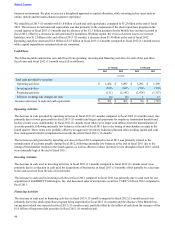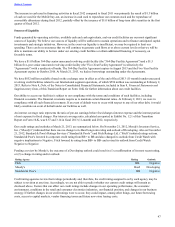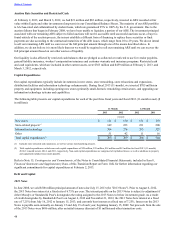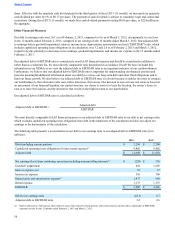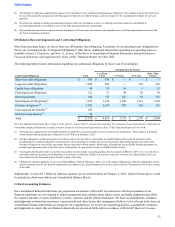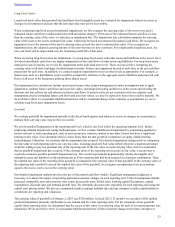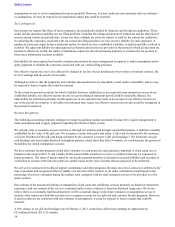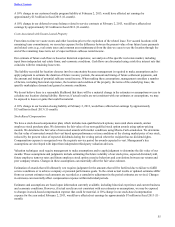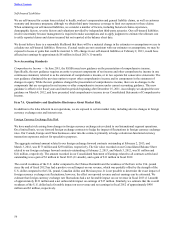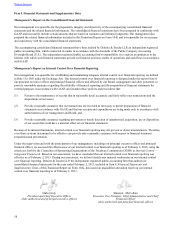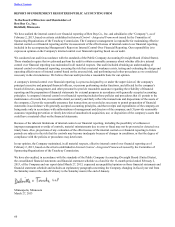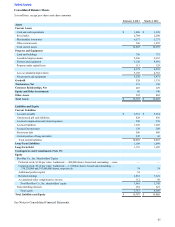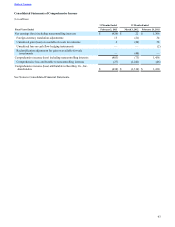Best Buy 2013 Annual Report Download - page 53
Download and view the complete annual report
Please find page 53 of the 2013 Best Buy annual report below. You can navigate through the pages in the report by either clicking on the pages listed below, or by using the keyword search tool below to find specific information within the annual report.
53
Long-Lived Assets
Long-lived assets other than goodwill and indefinite-lived intangible assets are evaluated for impairment whenever events or
changes in circumstances indicate that the carrying value may not be recoverable.
When evaluating long-lived assets for potential impairment, we first compare the carrying value of the asset to the asset's
estimated future cash flows (undiscounted and without interest charges). If the sum of the estimated future cash flows is less
than the carrying value of the asset, we calculate an impairment loss. The impairment loss calculation compares the carrying
value of the asset to the asset's estimated fair value, which may be based on estimated discounted cash flows. We recognize an
impairment loss if the amount of the asset's carrying value exceeds the asset's estimated fair value. If we recognize an
impairment loss, the adjusted carrying amount of the asset becomes its new cost basis. For a depreciable long-lived asset, the
new cost basis will be depreciated over the remaining useful life of that asset.
When reviewing long-lived assets for impairment, we group long-lived assets with other assets and liabilities at the lowest level
for which identifiable cash flows are largely independent of the cash flows of other assets and liabilities. For long-lived assets
deployed at store locations, we review for impairment at the individual store level. These reviews involve comparing the
carrying value of all land, buildings, leasehold improvements, fixtures and equipment located at each store to the net cash flow
projections for each store. In addition, we conduct separate impairment reviews at other levels as appropriate. For example, a
shared asset such as a distribution center would be evaluated by reference to the aggregate assets, liabilities and projected cash
flows of all areas of the businesses utilizing those shared assets.
Our impairment loss calculations include uncertainty because they require management to make assumptions and to apply
judgment to estimate future cash flows and asset fair values, including forecasting useful lives of the assets and selecting the
discount rate that reflects the risk inherent in future cash flows. If actual results are not consistent with our estimates and
assumptions used in estimating future cash flows and asset fair values, we may be exposed to losses that could be material. We
do not believe there is a reasonable likelihood that there will be a material change in the estimates or assumptions we use to
calculate long-lived asset impairment losses.
Goodwill
We evaluate goodwill for impairment annually in the fiscal fourth quarter and whenever events or changes in circumstances
indicate their carrying value may not be recoverable.
We test for goodwill impairment at the reporting unit level, which is one level below the operating segment level. Before
employing detailed impairment testing methodologies, we first evaluate likelihood of impairment by considering qualitative
factors relevant to each reporting unit, such as macroeconomic, industry, market or any other factors that have a significant
bearing on fair value. If we determine that it is more likely than not that goodwill is impaired, we apply detailed testing
methodologies. Otherwise, we conclude that no impairment has occurred. Our detailed impairment testing involves comparing
the fair value of each reporting unit to its carrying value, including goodwill. Fair value reflects the price a market participant
would be willing to pay in a potential sale of the reporting unit. If the fair value exceeds carrying value, then it is concluded
that no goodwill impairment has occurred. If the carrying value of the reporting unit exceeds its fair value, a second step is
required to measure possible goodwill impairment loss. The second step includes hypothetically valuing the tangible and
intangible assets and liabilities of the reporting unit as if the reporting unit had been acquired in a business combination. Then,
the implied fair value of the reporting unit's goodwill is compared to the carrying value of that goodwill. If the carrying value of
the reporting unit's goodwill exceeds the implied fair value of the goodwill, we recognize an impairment loss in an amount
equal to the excess, not to exceed the carrying value.
Our detailed impairment analysis involves the use of discounted cash flow models. Significant management judgment is
necessary to evaluate the impact of operating and macroeconomic changes on each reporting unit. Critical assumptions include
projected comparable store sales growth, store count, gross profit rates, SG&A rates, working capital fluctuations, capital
expenditures, discount rates and terminal growth rates. We determine discount rates separately for each reporting unit using the
capital asset pricing model. We also use comparable market earnings multiple data and our company's market capitalization to
corroborate our reporting unit valuations.
The carrying value of goodwill at February 2, 2013 was $528 million. In fiscal 2013 (11-month), we recorded a $822 million
goodwill impairment primarily attributable to our Canada and Five Star reporting units. For the remainder of our goodwill
outside these reporting units, we determined that the excess of fair value over carrying value for each of our reporting units was
substantial. We do not believe there is a reasonable likelihood that there will be a material change in the future estimates or
Table of Contents





